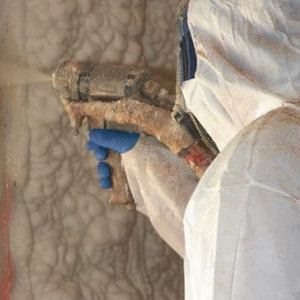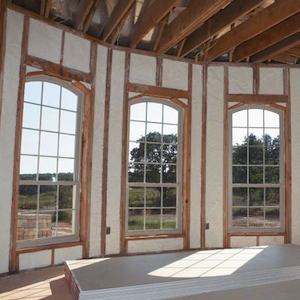Spray Foam Insulation

Spray Foam Insulation - Installation - CertainTeed
Spray foam insulation is exactly what it sounds like, a polyurethane- based foam sprayed into place in or on wall cavities, attic spaces, or roofs. It has the advantage of filling wall and ceiling cavities completely, blocking air leakage very effectively.
Spray foam insulation has an r-value of between 3.6 to 6.8 per inch, among the highest r-values of all insulations commonly used in home construction. It is nonflammable and meets all building code requirements.
Installation of Spray Foam Insulation
Spray foam insulation installation requires special equipment and must be done by a licensed contractor. Spray foam insulation is also quite toxic during installation, requiring protective gear and allowing several days of airing out after installation before occupying a space. As with any type of insulation, unless spray foam insulation is installed correctly, it will not live up to its rated energy efficiency.
Spray Foam Insulation Versus Fiberglass Batt and Cellulose Insulation
Spray foam insulation is advantageous over other types of insulation for a number of reasons.
- It can easily be blown into hard to reach areas or complicated ceiling spaces that are impossible to seal and insulate correctly unless foam is used.
- Spray foam insulation fills every nook, cranny, and gap in a wall cavity or ceiling space completely:
- it will not sag, separate or settle, maintaining its installed energy saving ratings over time
- it completely covers wood or steel wall framing studs which have R-values of 1 or lower, which can degrade the insulation performance of other types of insulation such as fiberglass batts.
Closed-Cell vs. Open-Cell Spray Foam Insulation
There are two main types of spray foam insulation, known in the industry as closed-cell and open-cell foam. Let's look at the attributes of each.
Open-cell foam insulation is soft, like a cushion. The cell walls of the foam bubbles are broken and air fills the spaces in the material, giving it a density of around 1/2 to 3/4 of a pound per cubic foot. Open-cell foam insulation has an r-value typically around 3.5 per inch.

Spray Foam Insulation - Cavity Wall - CertainTeed
Closed-cell foam insulation is a much more dense material, with a density of between 2 and 3 pounds per cubic foot. The cells or bubbles in this type of foam are not broken, resulting in a rigid material strong enough to walk on. The closed bubbles in the foam are filled with a special gas, which increases the insulation value of the foam insulation to an R-value of around 6 per inch.
Open-cell foam insulation is a porous material that can allow air and moisture to penetrate it, while closed-cell foam insulation is non-porous, making it very difficult for water vapor and air to pass through it. This porosity difference is the biggest difference between the two.
Due it its lower density, open-cell foam insulation uses significantly less material to produce and fill a space, making it less expensive and less resource intensive. Closed-cell foam insulation has a much higher R-value, but its high density requires more material to fill a similar space, making it the more expensive of the two. Think of it this way, one cubic foot of closed-cell foam insulation has about six times more raw material than one cubic foot of open-cell foam insulation.
Since spray foam insulation can be rather expensive in either form, a contractor may sometimes use less expensive insulation, such as fiberglass batts, on interior walls where the R-value is somewhat less important, using smaller amounts of spray foam insulation to fill cracks and gaps, to help keep costs down for those with tight budgetary constraints.
Deciding on which type of spray foam insulation to use depends on where it is going to be used in a home. For example, open-cell foam insulation is not used where a vapor barrier is needed, such as below grade where it could absorb water. Closed-cell foam insulation would be a good choice in small spaces where the greatest r-value per inch is required.
Both types of foam insulation are commonly used in home construction. A reputable and experienced foam insulation contractor will work closely with you to choose the right type of foam insulation for your home, depending on the conditions of the installation, energy savings required, and budgetary limitations.
comments powered by Disqus

























































































































































































